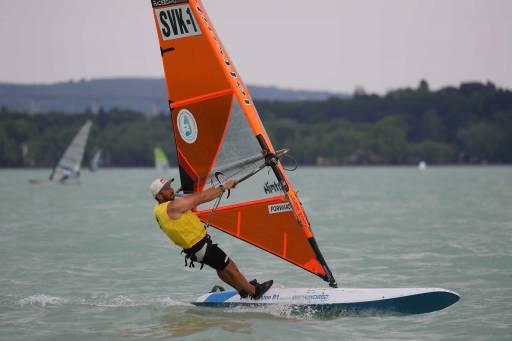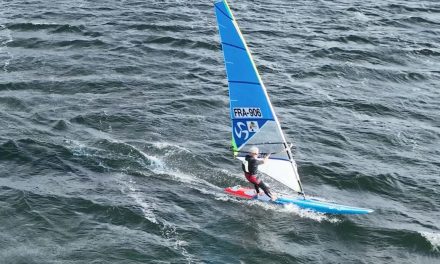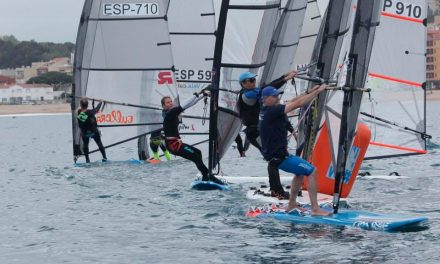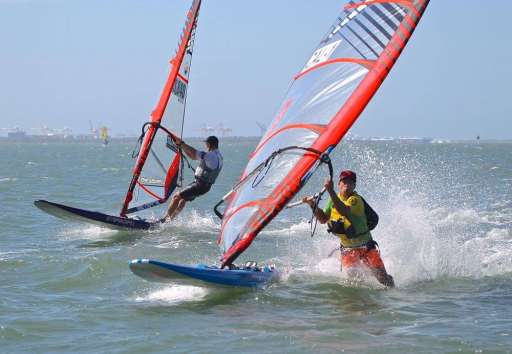Discussion with the passionate Radovan Kubin (Rado) who engaged last year a new raceboard model, the rVision R1 (https://www.rvision.fi/), presentation and question with Rado about his board and his specific production on the sidelines of huge manufacturers. A winning world title last year went to directly confirm his model is well born and will be then the board to battle.
First of all, congratulations Rado for your effective engagement in raceboard development. Could you present (your history in windsurfing (practice), area where you lived and lives, your link with board development since you have certainly study composites manufacturing or polymer chemistry, I imagine), then your historic job).
I am originally from Slovakia (born in Czechoslovakia to be precise) but have relocated to Finland 21 years ago. I started with windsurfing when I was 13 years old and have been competing since 1987. We had to build our own boards back then since long boards (DII, DI) were either not available or simply too difficult to get. I remember building my first raceboard by figuring out measures based on pictures in a magazine in the early 90s. Luckily I used that raceboard only a season or so and then got my first real raceboards from AHD, F2 and Fanatic before new generation of raceboards came up.
I have a Master’s in information technology, and I have worked in that industry all my working life. I like having projects in my personal life as well, not only at work. Therefore I always get inspired by new technologies or inventions.
I like raceboards produced in Europe and I though it was about time to make one using all the latest materials and technologies (including 3D modelling) to produce a high quality one.

What is your official involvement in windsurfing (you told me you are in the Finnish board sailing association, for example) and what do you defend?
I am a chairman of SPLL (Finnish Board Sailing Association). We cover almost all windsurfing classes and kitesurfing and windsurfing too. The main mission of the association is to develop the sports in scope further by getting more people interested in. We also update and maintain local class rules and event (including racing) calendar as a part of basic administration.
There are many interesting sports or hobbies that people, especially young generation, can do therefore we literally compete with all of them when trying to get more people into board sailing sports. Raceboard and long boards classes in general are not as attractive as some other newer classes for young generation. SPLL needs to ensure we don’t loose possible interest by too much promoting a class but rather we ensure people understand what all available options are including freeride equipment.
Can you tell what is rVision R1? A firm? A trademark? Where is it located and why?
rVision Oy is my own company that I have established to provide IT type of services originally. The company is in Finland in a capital city area. When I thought of starting a project related to raceboard obviously it was easier to start it under the same company utilizing available financial resources IT services produced. R1 is then the first raceboard product and therefore, the raceboard name. R1 stands for Rado1 which with a bit of imagination comes from Radovan (van pronounced as English “one”)
Can you describe your team around you to develop and produce?
This is the most interesting topic for me to explain. Back in 2017 when I decided to really invest to raceboard development I needed somebody to 3D model the vision I had in mind. My father, who has been using 3D modelling for ever, helped with the initial model. I tried to develop and build the board in Finland but I was missing a real company that had experience in building windsurfing boards. After getting first 2 prototypes built in Finland, I was almost sure that would be the end of the project. Luckily when trying to find a company that marketed carbon mast track for long boards I noticed that the company (Onehundredboardz) was also building custom boards. This is where rVision and Onehundredboardz collaboration started and we managed to get the prototype number 3 built very quickly in late 2020. Soon after that proto 4 came to test different wing and no wing options.
Once prototyping was over then it was ready to produce the R1 and this is where my good friend, graphically skilled, David Jones, helped. He had helped with the R1 logo design already for the first prototype but then getting the board design was different “ballgame » listening to all my wishes especially when I also collected colour preferences from the first possible buyers.
So long story short. The team is literally few people involved in R1 development and build. Collaboration with Onehundredboardz (Matic Meza being the main person) has enabled R1 getting the best custom-built technology and parts like carbon mast track. I focus on visual and shape designs while Matic focuses on the actual build.
To recognize and honour the collaboration – the rVision R1 powered by Onehundredboardz – is clearly stated on the sides of the board.
What was your objectives to built a model on the margin of world companies like Unifiber and Starboard? How you business model is reliable in front of companies who produced with a well-functionning system with world manufactures like Cobra?
The main objecting is building the board in Europe by utilizing all available technology and material to achieve high quality, light and durable board. As already mentioned, R1 is an outcome of my hobby project. I have got it officially registered to allow other competitors using it in official races.
We pay a lot of attention to all details and a build quality. Many parts of the board are cut by computer operated CNC machines based on own designs or manufactured to very precise moulds under high pressure. So the board consists of parts that we manufacture too.
R1 is literally a racing machine and as such can’t be really manufactured same way as world companies produce their boards. We can customize position of foot straps based on competitor preference and style.
… and how can you be competitive by your final price of selling since you include an important handmade time to build an High-tech model with a carbon sandwich technology and all knows that this time is very impacting in Europe. What is your final price with dag and mastrack?
Since I am not dependent on possible profit from R1, I can keep production in EU and control the price by literally selling the board for what it takes to produce by following direct-to-consumer concept. Current price is 3990 Eur excluding VAT. Ship to country VAT is charged within EU for purchases done by consumers. Let’s see how the price will need to develop in 2023 since every increase of energy or materials have a direct impact on it.
The daggerboard and mastrack are precisely a problem to produce alone a raceboard. How do you manage these strategic subjects to obtain them reliable, performant and with an acceptable cost?
As mentioned thanks to collaboration with many existing parts produced by Onehundredboardz, like the famous carbon mast track, are available. We needed to slightly further improve it to accommodate the abuse coming from higher speeds and bigger waves in which R1 can be used comparison to DII for which it was originally build. This is exactly the moment where raceboard experience helped a lot.
I have focused on daggerboard only in later 2022 and therefore the board was originally provided with DII fitted daggerboard and recommended to be used with The Boss R1 85 cm long daggerboard. R1 in this case meant special daggerboard head that was designed by me to fit R1 and optimally used daggerboard gasket space.
Since beginning of this year, we are delivering R1 with a brand new 85 cm daggerboard that is a very solid part of the board. The shape is very close to The Boss R1 daggerboard but then the hydrodynamic profile is slightly different.
A second very important point is the daggerboard housing which is a very technical part of the part since it must be very sustainable and light. Many shapers coming from surf, paddle or funboard who wanted to build a raceboard with dag, were in front of a real difficult subject to build it. This part can become a nightmare for the manufacturer is it not robust.
Yes, daggerboard housing or gasket as we call it make any windsurfing board production timely. The gasket needs to be built separately before putting to the board during / before lamination. Once everything is done then the daggerboard gasket lip needs to be glued.
This is also another part where R1 differs. Gasket is very precise; daggerboards are very light and everything works smoothly.
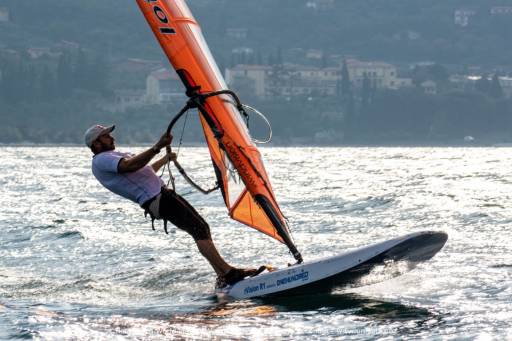
What was your final choice in term of technology and why did you choose to shape instead of to target an hollow board which should be lighter (a foam is aournd 5 kg for 300L). The last manufacturer who did it, as far as we know, was Lechner with similarly to you, a semi custom production.
Sorry for correction, the latest manufacturer is my friend Kale from Finland who just managed to get his raceboard registered with World sailing.
I was never a big fan of fully hollow boards. 300 L volume has a lot of air, and a lot of condensed water can be created. I would be more in favour of filling the space with super light expandable foam then having the board fully hollow. IF hollow board breaks, then it can be filled in with water very quickly and getting back to shore might turn to real life saving exercise. Such production requires some R&D and surely bigger amounts of boards to be manufactured.
I used R1 in 17 m/s wind and 7.3 m2 slalom sail. The board was more in air then on water and hit 1.5 to 2 m high waves in high speed. R1 handled the situation perfectly, no damage, all parts functioned as designed. If I had crashed and broke the board by boom or mast or simply colliding with other board or other object, then I would have been still able to come back since sandwich laminate doesn’t allow board to sink.
Is it difficult to fully respect an identical production series by your way of making since all registered models to WS must be absolutely identical.
Following allowed tolerances is not so difficult. Everything is designed in computer 3D, cut by computers, laminated to moulds when possible. We measure all boards carefully and provide certificate with it. Therefore every customer knows the exact weight of the board.
Your chosen shape is successful since your board won a double world title last year with Patrik Pollak. Perfect proof of concept ! What was the specific details did you work with your team to reach a top performance upwind and downwind ? Scoop? Outline? “batwing” design? We heard Patrik was particularly efficient downwind for planning.
Patrik, my brother-in-law, and a very good friend from childhood, is simply very strong competitor in many classes.
I have designed the board for more lazy and slightly heavier competitors like me. Therefore, the question was whether Patrik wouldn’t be slowed down as a board for him can have smaller volume than R1.
When I sent the first video footage from me on proto 4 he got interested in. When he got his R1 I believe he was still a bit worried whether the board designed by me can really get him to the very top but after few trainings he was one body with the board ready to win.
R1 protos and R1 final product were designed and tested in demanding Baltic Sea conditions by me mainly. Baltic waves are high with short length. I put a lot of effort to find the best shape that can cope with such waves in upwind and downwind having the best angle possible.
I don’t want to open the shape details up too much but let’s say that without the R1 wings the board wouldn’t be the same.
To finish this long interview, a major problem to reach a large development of raceboard is currently its accessibility. Now, boards are very easy to use, not so technical and performant everywhere in all wind conditions. This is the definitive advantage of raceboard. But it is now relatively expansive and brittle due to the high chosen technologies by all the manufacturers. Do you believe to produce a “cheap ” an European raceboard for all, , similarly to the windsurfer, who wants a dag, a robust with a performant shape to sail long distance, grouping in clubs, … with targeting the absolute performance?
It all depends on demand and upfront investment. Unfortunately, competitors loyal to Raceboard class are limited. Those who really want to compete demand high quality boards, including me.
If there was a big demand in developing and building European produced affordable raceboard then there would be also interest from possible investors. On top of that a support and dedication from all bigger European windsurfing communities, countries are needed too. Under those circumstances there would be a will to make it happen.
I am currently focused on high performance raceboard.
Having said that, I would gladly help with developing affordable raceboard if there was such a question asked from me.
What would you like to add?
The big question is always what’s next.
Next, I would like to make more people happy by enjoying good quality R1 raceboard. I would like to try some other technologies, possibilities building up R1 raceboard, and lastly it would be nice to bring up a model with a bit smaller volume too.
Thanks a lot for your involvment and congrats again for your success. Have again successes in 2023
